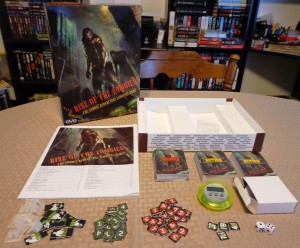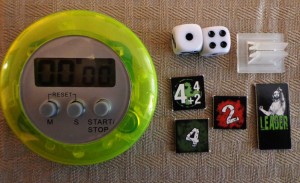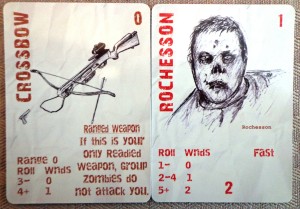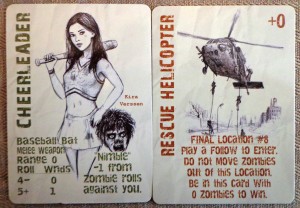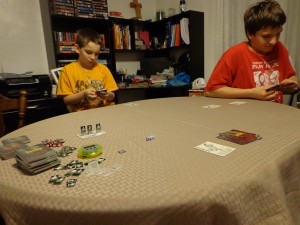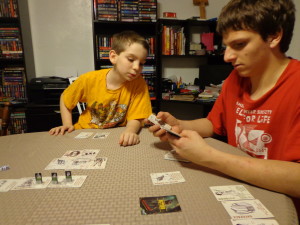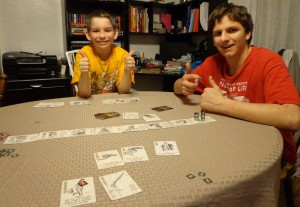Games like “Castle Panic” and “Pandemic” are well received in my household, mainly because the kids get to team up with dad instead of being forced to match wits with him. It’s also rare that I come across real-time based board games (“Damage Report” being the last one), but when I do, we generally have a good time. “Rise of the Zombies!” combines these two mechanics and thrust the kids and me back into the world of the undead, a place we frequent often. This time around however, we were working together to stay alive as opposed to trying to eat each other’s brains. Before we get started, I’d like to thank Dan Verssen from Dan Verssen Games for providing me with a free review copy.
Components
Cards – There are one hundred and sixty-eight cards that players will make use of during the game. Survivor cards list a special person or survivor that players will assume the role of for the duration of the game. Action cards do a number of things to give players special advantages and are made up of location cards, weapon cards, item cards, companion cards, instant action cards, skill cards, and location attachment cards. Location cards, which are part of the action card deck, allow players to progress from the starting point (the safe house) to the end point (helicopter). Finally, zombie cards serve to slow or stop survivors on their journey.
Dice – There are two, six-sided dice used primarily for combat.
Character Stands – There are eight plastic character stands, each player receiving one to hold up the character they choose. There are a total of thirteen different characters to choose from, each with a unique ability for players to utilize.
Counters – These counters / tokens help players keep track of the various things as they happen throughout the game. Green counters represent experience and red counters represent damage. One group counter remains in play at all times, which is used to remind players of player health / hand limit, the overall infestation modifier, and etc. The more people that are playing, the harder the game becomes to balance things out.
Digital Timer – The timer determines when the game officially starts and ends. The game can end sooner, should all players meet the required conditions.
Setup & Gameplay
First, the safe house card is placed on one end of the table and the helicopter card is placed on the other end of the table. There should be about seven card lengths between them. Each player receives a character stand, a survivor counter to place into the stand, and the corresponding survivor card. The action card and zombie card decks are shuffled separately and placed off to the side. Players determine how difficult they’d like to make the game by setting the time on the digital timer (the rulebook contains a chart to help guide players). The appropriate group counter is placed nearby, which will depend on the number of people playing and will change based on who dies off during the game.
Unlike most board games, turns in “Rise of the Zombies!” occur in real-time. This means that while you and your group are thinking about your collective turn, a timer is ticking away in the background. Gameplay alternates between survivor turns and zombie turns, which can be summarized as follows:
Survivor Turns – At the beginning of a survivor turn, players discard cards and draw new ones up to their hand limit (which is equal to their current health points). Then using those cards, players can perform actions in any order they’d like, or at the same time. It’s important to keep in mind that there are no individual player turns. Players can take as many actions as they want so as long as they have the ability to do so, which includes trading cards with others in the area, trading in experience points to play certain cards, and etc.
Zombie Turns – During a zombie turn, the zombies perform move, attack, and spawn actions, in that order. Zombies move one card closer to the nearest survivor, attack any survivors if they are present at their location, and spawn (one zombie card) one card behind the rearmost survivor.
Combat is fairly easy. It involves rolling a six-sided die and adding to that value any bonuses that the player may have. The player would then check their weapon card to see how many wounds were inflicted in the attack. Inflict enough wounds to kill a zombie and the zombie card becomes yours to later trade in for various reasons. Instead of keeping the zombie card, you can opt to simply collect the green experience point counters.
Players will be endeavouring to place location cards to get from the safe house to the helicopter. Zombies spawn with each new location card, based on the progress of the group and the current infestation modifier. The winners are those who make it to the helicopter before the time limit expires with the added rule that no zombie cards can be present at that location in order to claim victory. The rule book includes rules and scoring for an optional campaign game, which is simply a test to see how many points you can accumulate over three games.
The above is simply an overview of the rules and doesn’t cover everything found in the manual, but should give you an idea of what the game is like. For more detailed information, please visit the links I provided at the end of this article.
The Review
In terms of components, the artwork is superb and the cards fairly thick / sturdy. The timer wasn’t difficult to use and was large enough for me to read, even with my poor eyesight. The counters were easy to figure out and to keep track of at a glance. I have no complaints in this department as everything was easy to use, figure out, and put away. I would have liked extra baggies for the cards and counters, but this is a minor complaint.
The gameplay is fast and furious, but satisfying nonetheless. I particularly like the fact that you can upgrade and improve upon your character by trading in zombie cards / experience counters. I’ve always enjoyed a “level up” mechanic in games as they give me a reason to keep playing. I appreciate that I can take my actions whenever I want during the survivor turn, rather than having to wait for other players to make their moves. The learning curve is moderate to high, as there are special rules and symbols to look out for that effect various gameplay elements. I’d give your group some extra time on your first game to review the rulebook and possibly add extra time to the timer to help offset the time spent looking up questionable rules as they come up. The rulebook frowns upon stopping the timer for any reason, but I don’t mind making whatever rule changes are needed to make sure the kids are having a good time. To that end, I appreciate that the game is flexible enough to accommodate any group’s play style.
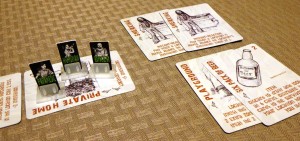
Mechanics like “following” and finding ways to reduce the infestation count take time to get used to.
The cooperative element is an especially welcome feature as it gives players a common goal to strive for as a team. On the other hand, a team is only as good as the weakest member of the group, which is where strategy comes into play. While working as a team is important for survival, it may benefit the group to leave behind someone who just is just too far gone to catch up. Helping another player may serve to set you and the team back, depending on the circumstances. Play experiences and willingness to help others will vary from group to group…after all, not everyone will share the “no kid left behind” rule that I incorporate when I play cooperative games with the kids.
Anthony (17) and Vinnie (11) both enjoyed the experience. Vinnie took on the role of a biker while Anthony played the historian. Both of them had some pretty unique starting weapons, which made them our offensive line. I, on the other hand, opted to play as the paramedic. While I didn’t have a starting / default weapon, I was able to spend my free attacks to heal wounds. In MMORPG terms, they served as the tanks and dps (damage per second) while I sat back and healed them from a semi-safe distance. I traded them offensive cards while they gave me the support items I’d need to keep everyone afloat (first aid kits, etc.). We also coordinated our attacks to ensure that those that needed the final hit for the experience would get it. It all worked out very well and we defeated the game as a team with about thirty minutes to spare (starting with seventy-five).
My only real concern about this game is the price. The website has the game listed for $39.99, which might turn some people off considering the number of components involved. While I appreciate the artwork and the inclusion of a timer, it’s hard for me to justify the price tag, especially when games like “Stone Age” offer two/three times the components at roughly the same price. I’ve never had to deal with production costs in the gaming industry, so it’s possible that I’m wrong in my reasoning. Whether or not the price is acceptable is something that the individual must determine for themselves, but it’s worth mentioning anyway.
Overall, “Rise of the Zombies!” turned out to be a fun, cooperative game that is unique enough to stand apart from the rest of the games in my collection. It reminds me a little of “Left 4 Dead”, a game series I frequently play on the PC. Due the violent nature of the game itself, I couldn’t recommend it to kids under the age of twelve. The cards aren’t overly graphic or bloody, so I was fine with letting my eleven year old (soon to be twelve) play with parental supervision. You parents out there will need to determine for yourselves as to whether or not your child is mature enough to play this game, though I’d still recommend parental supervision regardless. If the price doesn’t bother you, then it’s worth picking up, especially if you regularly hold play sessions with a group of friends and enjoy games with a cooperative theme. Whether you buy the game or not, it’s definitely worth looking into.
Final Verdict: 7/10
—
You can learn more about and purchase “Rise of the Zombies!” by visiting the official website and BoardGameGeek, here:
http://boardgamegeek.com/boardgame/126025/rise-of-the-zombies
—

